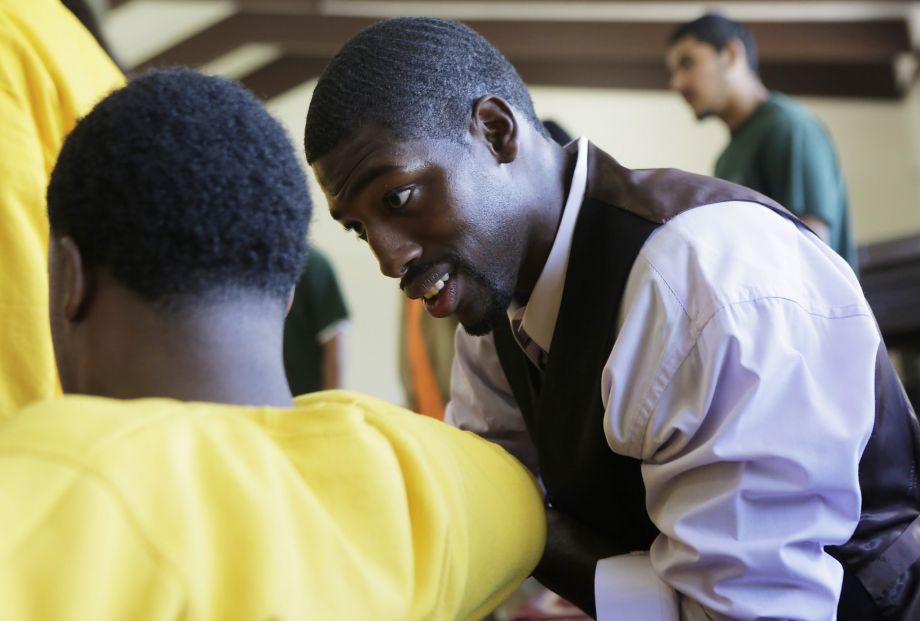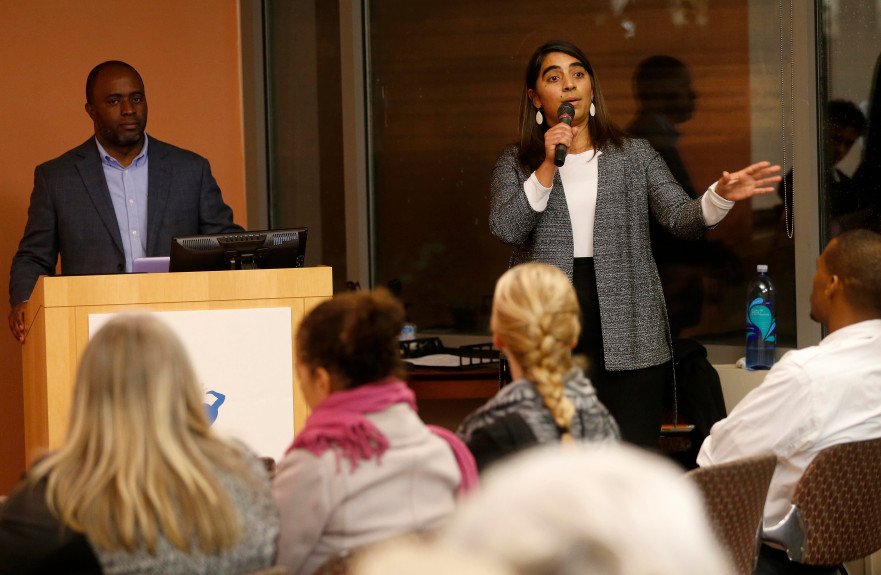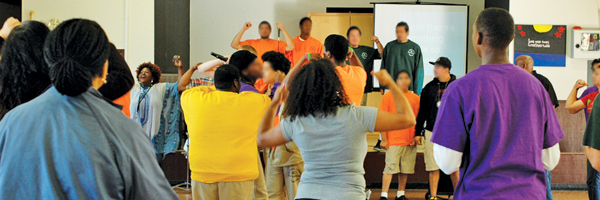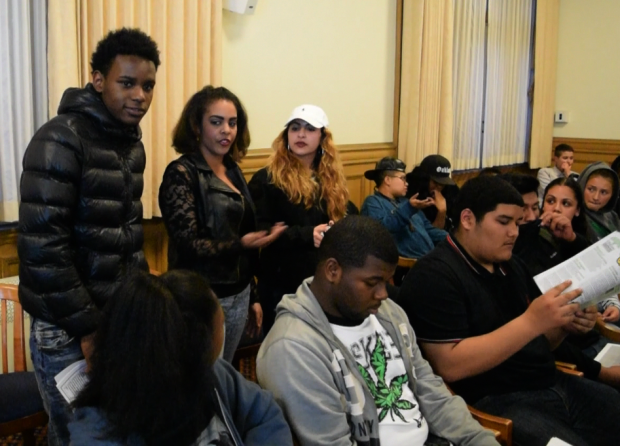MOST RECENT PRESS
HARD KNOCK RADIO–Podcast Interview (23 Min In) Reimagining Public Safety and Chief Is My Belief!
San Francisco Chronicle-Nia Wilson: ‘A young girl growing up in Oakland and doing her best to get through’
San Francisco Chronicle – Reimagining Public Safety Task Force-‘Defund the police’ is more than a protest cry for these youths. They’re helping steer Oakland effort


Published 8/6/15
Oakland probation camp offers Freedom School to young detainees
—–
The nearly three dozen teenage boys — laughing, dancing, chanting and singing — didn’t look like robbers, car thieves or vandals. They looked like goofy kids at summer camp.
In fact, it was a camp, a probation camp. The youths were required to be there, most assigned by a judge to spend six to nine months at the Alameda County minimum-security detention center, Camp Wilmont Sweeney.
They weren’t allowed to leave. But the smiles, the singing and the dancing? That was Freedom School.
In recent years, the Freedom School, a national summer or after-school literacy program with roots in the civil rights movement, has found a place in probation camps, tailoring the instruction and books to juvenile offenders, many of whom have had little success in school or community.
Freedom Schools, resurrected in the 1990s by the Children’s Defense Fund, focus on building self-esteem and a love of learning by connecting with the communities and backgrounds of the often low-income students. There are 34 Freedom School programs in California, with a handful in probation camps.
Camp Sweeney administrators held a six-week pilot program last year, and veteran juvenile probation officers said they’d never seen anything like it.
‘It’s pretty special’
Dale Tafoya, Camp Sweeney institutional supervisor, shook his head as he watched the boys fling their arms around each other as they participated in the daily Freedom School Harambee, a 30-minute gathering that includes cheers and chants, a motivational song, and announcements to begin the day.
“They have all bought into it,” Tafoya said. “It’s pretty special.”
Boys who might be enemies on the streets were dancing, their arms intertwined, their juvenile institutional officers dancing, too. The youths sang, “Something inside so strong. I know that I can make it. … You thought that my pride was gone. Oh no, oh no, there’s something inside so strong.”
When the song ended, Tafoya shook his head again. “You don’t see this,” he said. “This shows you it’s possible.”
The “it” is the youths’ sense of hope and confidence, things they typically lacked when they were arrested, convicted and sentenced to juvenile hall before their stint at the camp in San Leandro.
LaDonna Harris, the county’s chief probation officer, saw the shift in the boys during last year’s pilot program. She set aside $100,000 to pay for the program. Then she found an additional $60,000 to send 12 of her juvenile justice campers to visit historic civil rights sites in the South and Los Angeles.
Harris said some have criticized the expense, saying these boys don’t deserve a special summer camp or a trip across the country at taxpayer expense. Harris’ eyes turn steely as she recounts such conversations with community members.
These boys will go back to the community eventually, she said, and Freedom School has ensured that “when they go back, they’re a different person than when they came.”
Love of reading
When Justo arrived at Camp Sweeney this year, he was behind in school. He never read books. Now, with Freedom School ending Thursday, he has caught up on credits and loves to read. And, the street feuds that put some of the boys in the juvenile justice system now seem silly, he said.
“I’m over here with somebody if I was on the outside I would consider an enemy to me,” he said. “That’s just tearing our race and the community apart. That’s what I realized here.”
During the regular school year, Camp Sweeney students work at their own pace, working on whatever coursework they need to graduate high school. Officers are always present to make sure there are no problems. At Freedom School, the kids work on the same curriculum, read the same books — mostly about the struggles of young people — and create art projects. The institutional officers sing with them and sit in on group discussions and with the art projects.
Hunter, 16, was sent to Camp Sweeney at the beginning of the summer. He had a “1,000-pound” chip on his shoulder, he said, most of it related to his dad’s absence in his life.
“My motto was, I came here alone, I’m going to leave alone,” he said.
Bonds formed quickly
That didn’t last long. Hunter quickly formed bonds. He joined class discussions about books they read. His teachers encouraged him to write things down, especially about his dad. He did, and the 1,000 pounds lifted, Hunter said.
He is now on track to finish high school early, and then he wants to go to barber school. First, he has to finish the months left on his Camp Sweeney sentence. He’s OK with that.
“You can be free wherever you are,” said Brooklyn Williams, of the Lincoln Child Center and the Camp Sweeney Freedom School director. “Hunter is more free in here than he was out there.”
Freedom School Gives Juveniles New Hope
The Freedom School students start the morning with the Harambee exercise. The faces of the juveniles are blurred in accordance with the detention center’s rules.
By Jim Knowles • San Leandro Times
The campers were up first thing in the morning, singing and dancing to get their day started off right.
This summer camp the hills above San Leandro has a little different focus, though. The campers are in juvenile detention for committing crimes. Camp Sweeney’s purpose is to help them find a path to a more successful life.
A new summer program – called Feedom School – is designed to boost motivation to read and learn, and change a young person’s image of himself. The program is just wrapping up its summer at Camp Sweeney at the Alameda County Juvenile Detention Center on Fairmont Drive.
Freedom School is a nationwide program for incarcerated youth, ages 15 to 19, with a focus on the positive. It’s based on the Freedom Summer during the Civil Rights movement with the support of the Children’s Defense Fund. The teachers are called servant leader interns and they took the course at the Freedom Schools’ training site in Tennessee.
The students start each morning with a ceremony called Harambee, a Swahili word for “let’s pull together,” a sort of pep rally to boost spirits and to affirm every student’s value. Then they go to their classroom for English, history and math.
Right after the Harambee ceremony one day last week, the teens heard a talk from Derrick Bedford, a supervisor at the probation department. Bedford, an ex-felon, told the kids how he grew up in Brookfield in East Oakland and got involved in the “fast life” and was eventually facing a long prison sentence.
080615n3“Not a day goes by that somebody doesn’t piss you off,” Bedford told the young men. “But you will never have peace of mind by giving somebody a piece of your mind.”
A lot of times a kid’s trouble started with money, and not wanting to be a financial burden to their family, said Brooklyn Williams, the director of the Freedom School program at the detention center.
So one of the classrooms this summer has a financial theme, another classroom’s theme is sports. There are lots of jobs in sports besides being an athlete – sports photography, nutritionist, equipment manager, said Williams.
At the heart of the Freedom School program is changing your self-image. Williams points out the students’ art work on the classroom walls, including the drawings students made of themselves.
The assignment was to make one side how society sees you, and the other how you see yourself, Williams explains. There’s a remarkable difference between the two sides of the papers the teens drew on – on one side are adjectives like thug and no good and drawings in the same vein, and on the other side the way the youths see themselves is good-hearted and somebody who wants to contribute to society.
“It’s about first changing yourself,” said Williams. “And then it’s family, community, country and the world. You might not be able to change your family but you can change the way your own children grow up.”
If it seems a stretch to go from a teenager who gets locked up to a bright young person who can change the world, that’s the point of Freedom School. It’s built on the themes of Freedom Summer and Martin Luther King’s ideals.
Williams went to the Freedom School program in Tennessee and teaches school in Oakland during the school year. The program at Camp Sweeney just runs during the summer.
One of the keys to making it work is combining the staffs of the probation department with Lincoln Child Center in Oakland and the Alameda County Office of Education, so that teachers and institutional officers come together, Williams said.
Probation Chief La Donna Harris brought the Freedom School program to Alameda County after seeing it work in Los Angeles.
Harris said it was a problem finding the resources to make it happen, but it became possible with the help of the Lincoln Child Center and state Assemblyman Tony Thurmond, who focuses a lot on education, youth and crime prevention.
“You have to see it,” Harris said. “Here’s a group of young people who have struggled in life. The instruction is relevant and it’s taught by people like them from a variety of backgrounds.”
The non-traditional school engages the student more with both the probation staff and teachers and Lincoln Child Center staff.
“It’s almost one-on-one instruction, which is what youth need to recover credits and get back on track in school,” Harris said.
It’s ironic to be in a program named for freedom in a detention camp where you’re deprived of freedom, Williams said. But she’s convinced that the program is working.
The important thing is to keep that uplifting attitude once you get out, to be ready to go to work.
“The handoff when youth return to the community is important,” Williams said. “A lot of young men are ready to go when they get out.”
CAPTION 2: Juvenile institutional officer Gloria Wadud has her classroom decorated in a sports theme by her students in the Freedom School program at Camp Sweeney.
Posted
The City of Oakland’s Youth Advisory Commission, which serves as a liaison between local policymakers and young people, recently released recommendations on improving relations between local law enforcement, the communities they police and the city’s youth.
Several young people presented the recommendations at last week’s Public Safety Committee meeting, advising councilmembers about issues that impact their lives.
The Youth Commission brought together nearly 75 participants between the ages of 13 to 21 from many community-based organizations. The young people discussed among themselves what steps can be taken towards ensuring the welfare of their communities.
“We asked each of the groups to come with five recommendations already ready, and then the entire assembly chose their top five,” said Chantal Reynolds, a member of the commission’s staff.
“Now they’re having those conversations with city officials, and some of the youth met with the Chief of Police and went through the recommendations with him,” she said.
Brooklyn Williams, a youth leadership advocate who helped convene the youth meetings, said she was responding to the absence of young people’s voices in many hearings and decision-making meetings.
“What adults need to understand is that when you partner with youth, you automatically increase efficiency and maximize resources because they are our most valuable resources,” said Williams.
Mack McGhee, who was a Student Voice Ambassador for Oakland Unified School District’s All City Council at the time, was one of the students who spoke with Chief Sean Whent and presented at the Public Safety Committee.
“Before going through this process, I wouldn’t have even spoken to a police officer unless there was no way around it, because of the way things are happening throughout the country,” said McGhee.
“What the experience did was it re-humanized police officers for me but also taught me there’s a lot that needs to change with law enforcement as a system,” he said.
The top five recommendations selected by the youth were:
Create a committee to retrain law enforcement officers to use non-lethal force when subduing suspects. It also proposes implementing Youth Lead Trainings that would help teach officers about the culture and lived experience of Oakland’s inhabitants;
De-militarization of the Oakland Police Department (OPD). The report states that, “OPD should not use weapons used in war (e.g. tanks, military trucks, other military weaponry, etc.) against the residents and citizens of Oakland;”
Youth should be asked to serve on police hiring panels and committees;
The city should hold “Know Your Rights” trainings throughout Oakland for residents to understand the proper ways to “safely navigate encounters with law enforcement officers;”
Police officers should be required to live in the communities they patrol for a certain number of days per week, and that law enforcement agencies develop a more diversified police force.
According to the report, youth feel that law enforcement does not reflect the population it comes in contact with and many officers are not from Oakland. Instead, they come to Oakland to police residents and then go home.
“This does not lead to vested interests in a community or sustained relationships with residents,” says the report.
Some additional recommendations in the report include the establishment of a Youth Citizens’ Review Board for all law enforcement agencies; eliminating paid leave when officers are suspended during investigations for misconduct and officer-involved shootings; a database to document the victims of officer-involved homicides and brutality; and a special prosecutor from outside the local system assigned to review all officer-involved shootings.
According to Williams, the youth groups had created the recommendations about a month before President Obama’s Task Force—a team of experts researching policing— unveiled their own recommendations in the wake of the Ferguson protests.
What the Youth Commission saw was that most of the experts’ proposals for improving relations between law enforcement and communities directly aligned with those that had been made by the team of young people.
“The level of brilliance of our Oakland youth is really inspiring,” said Williams. “I’m hoping that more leaders and decision-makers have this awakening so that all of our departments eventually have their own youth panels and advisory councils.”
Freedom School Provides New Hope for Probationary Youth in Alameda County
by Sophie Ho July 31, 2015
When Monica Vaughan said, “Good morning,” the group of 32 young men seated in the sun-drenched auditorium jumped to their feet. “Good morning — G-O-O-D M-O-R-N-I-N-G!” they chanted, clapping their hands and stomping their feet. Some of the young men danced.
Vaughan laughed, taking the welcome in stride. Moments before, the male teens had finished the first part of the morning assembly — the “harambee” (a Swahili term that means “Let’s pull together”) — in which they had danced, sung, and chanted. Energy was high in the room, and some of the young men had rapped into the microphone, so their loud welcome — albeit unusual — was not out of the norm.
Vaughn was there as a guest speaker at a special six-week summer reading program at Freedom School at Camp Wilmont Sweeney, a youth probation camp in the hills of San Leandro. Vaughn is the chief of schools for the Alameda County Office of Education. Each week, Freedom School staffers invite members of the community to their morning assembly to talk about their careers and read excerpts from books to the young men, who are on probation. The morning I visited, members of the probation office staff also sang and danced with the young men.
The “harambee” and the read-aloud guests are two fixtures of the program at Freedom School. Later in the day, the young men read books about youths not unlike many of them, who may have gotten into trouble or grew up in difficult socioeconomic conditions. The program is designed to help the young men with their reading skills, but for the people who work there and its participants, the Freedom School also provides an important community.
The Freedom School at Camp Sweeney is one of many funded by the Children’s Defense Fund, a nonprofit child advocacy organization. The Children’s Defense Fund backs Freedom School programs nationwide, and supports 34 such programs in California. Camp Sweeney is the only juvenile probation center in the Bay Area that hosts a Freedom School, although there are other schools in Oakland that also offer the program.
LaDonna Harris, Alameda County Chief Probation Officer, said she first learned of Freedom School when meeting with Los Angeles County probation officers who had implemented the program and they told her they saw positive changes in their youth. Her interest was piqued after hearing about the amount of excitement the program had generated in Los Angeles, as well as the culturally relevant material in the reading program.
The books selected include We Were Here by Matt de la Pena, which describes the story of boys running away from a group home, and Tears of a Tiger by Sharon Draper, which features a group of young men who get into a car crash after a night of drinking and killing one of their own in the process. After reading the books, the students discuss them and do projects related to them.
“We’re trying to see what’s going to get them to think differently, to want to be different, to want to have an outcome that is different than what the statistics tell them their outcome will be and help them find the spaces they will fit in and that will get them to be where they want to be,” Harris said.
In an open discussion, many of the young men said they grew to like reading these books. One young man said that the harambee was one of his favorite parts about school, but that he also liked the readings. “The books they give us are about us — you know,” he said.
Unlike the Los Angeles Probation Freedom School, Camp Sweeney’s Freedom School program has a blended staff, with employees and teachers from the Alameda County Probation Office, Lincoln Child Center, and the Alameda County of Education. Brooklyn Williams of the Lincoln Child Center, a nonprofit that provides programs and services to families impacted by trauma and poverty, is the director of Camp Sweeney’s Freedom School.
The program is organized thematically — this summer, the theme is making a difference. Each week, the students read books and do projects based on themes ranging from making a personal difference to making a difference in the community or the world. The students organized a food drive as part of the theme — food that could be given back to some of the students’ families.
“A lot of the [young] men were arrested because they were trying to get money for their families,” Williams said. “It’s important to give them a sense of giving back to the family, and give them a different version of what that looks like.”
One of the challenges that Harris noted, however, is continuing to support the young men after they leave Freedom School, and later, Camp Sweeney. She said there were concerns about maintaining the level of excitement for learning after the school concluded, as well as transitioning back to community schools with more traditional structures. Williams said that Freedom School had certain aspects, such as the morning assembly and guest speakers, that other schools could emulate. Both Harris and Williams are also encouraging other juvenile probation centers to observe their school in hopes that other systems might implement the program as well.
Some of the boys at the camp, when asked, said they had never been excited for school until Freedom School. One asked Vaughan how to get Freedom School to be year round.
One teen said that before he got to Freedom School, he did the bare minimum to pass regular classes and get by. Where he’s from, he said, people hesitate to let their children off their porch for fear of violence. When he gets out of Freedom School and Camp Sweeney, he said he wants to be a barber and help provide for his community, encouraged by his teacher to pursue his hobby of cutting hair.
“When I got here, I don’t talk to nobody — I thought, I came here alone, I’m going to leave alone,” he said. “But now I got all these friends and once we get out of here the team will stay together. I learned about the domino effect on how I want to make my community better and it can start with just one person. I want to help and I want to change something.”

Camp Sweeney Freedom School Director Brooklyn Williams, right, speaks during a forum on the AB1488 bill at the East Bay Community Foundation in downtown Oakland, Calif., on Wednesday, Nov. 15, 2017. To the left is state Assemblyman Tony Thurmond. The bill advocates for teens to receive more services when leaving the juvenile justice system. (Jane Tyska/Bay Area News Group)





 State Assemblyman Tony Thurmond speaks on AB1488 at the East Bay Community Foundation in Oakland, Calif., on Wednesday, Nov. 15, 2017. (Jane Tyska/Bay Area News Group)
State Assemblyman Tony Thurmond speaks on AB1488 at the East Bay Community Foundation in Oakland, Calif., on Wednesday, Nov. 15, 2017. (Jane Tyska/Bay Area News Group)